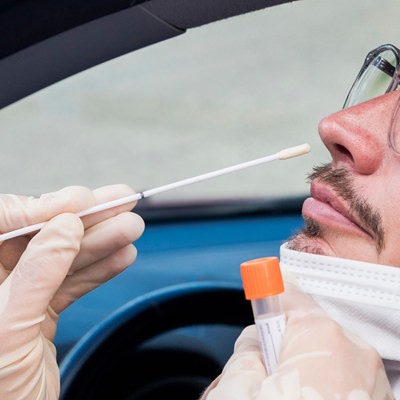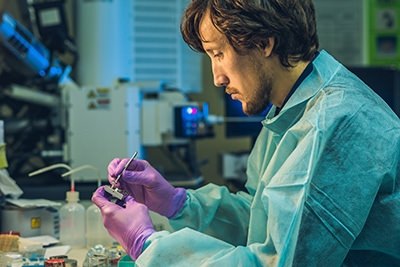Note: This paper is intended as an overview on the topic of sampling swabs and not as an authoritative how-to guide. Consult CDC and other similar sources for specific guidelines. Per CDC guidelines, “All testing for SARS-CoV-2 should be conducted in consultation with a healthcare provider."
The COVID-19 pandemic of 2020, which is caused by the SARS-CoV-2 (commonly known as the novel coronavirus), has caused a huge spike in demand for sampling swabs. While there have been swab shortages to fill the urgent need of COVID-19 testing, care still needs to be taken to qualify and source the best swab for the type of sampling that is required.
Chemtronics offers a line of Coventry™ Sterile Sampling Swabs [https://www.chemtronics.com/coventry-flocked-sampling-swab] that are FDA approved and manufactured and sterilized to the highest standard.
The following is a guide that provides an overview of sampling used for COVID-19, flu and other similar testing. For more information, go to CDC guidelines at https://www.cdc.gov/coronavirus/2019-ncov/lab/guidelines-clinical-specimens.html.
Methods of Sampling
When performing initial diagnostic testing for SARS-CoV-2, the CDC recommends sampling from the upper respiratory system with one of the following methods:
- Nasopharyngeal Sampling
- Oropharyngeal Sampling
- Nasal Mid-Turbinate Sampling
- Anterior Nares Sampling
Nasopharyngeal Sampling
Nasopharyngeal sampling collects a nasal secretion sample from the back of the nose and throat. Per CDC recommendations, the swab should be made of a synthetic material with a flexible wire or plastic shaft.
Chemtronics® offers the Coventry™ Sterile Flocked Swab (part #66000ST, see fig 1) that has been engineered to efficiently collect biological fluids for elution and analysis. Flocked nylon fibers provide greater surface area to collect and absorb secretion, and is also more comfortable than many alternatives.
 Fig 1 – Coventry 66000ST Sterile Flocked Swab
Fig 1 – Coventry 66000ST Sterile Flocked Swab
The head material of Coventry 66000ST Sterile Flocked Swab is a nylon microfiber with a polystyrene (or ABS) handle. Microfiber provides high surface area for rapid capillary absorption of fluid specimens. Flocking (brush-like nylon fibers) is ideal for sample collection from irregular surfaces. The head material structure is linear and open which both facilitates rapid absorption and thorough release of the specimen into analyzing solutions.
Nasopharyngeal sampling procedure:
(per CDC guidelines)
- Tilt the head back at a 70 degree angle.
- Insert the swab through the nostril, and keep it parallel to the palate, not upwards (Fig 2).
- Make sure you stop when you feel resistance or the distance from the ear to the nostril is the same, which indicates the swab head is in contact with the nasopharynx.
- Gently roll the swab handle in your fingertips, which rotates the swab head.
- For several seconds, keep the swab in place to absorb the maximum amount of nasal secretions.
- Remove the swab from the nose slowly and carefully while rolling it in your fingertips. (see fig 3)
- Insert the swab head into a sterile transport media tube, snap off the swab handle at the break-point, seal the cap, and label the sample (Fig 4).



Fig 2, 3, 4
Oropharyngeal Sampling
Oropharyngeal sampling collects a secretion sample from the back of the throat. Per CDC recommendations, the swab should be made of a synthetic material with a flexible wire or plastic shaft.
Chemtronics® offers the Coventry™ Sterile Foam Swab (part #66120ST, see fig 5) that has been engineered to efficiently collect biological fluids for elution and analysis.

Fig 5 – Coventry 66120ST Sterile Foam Swab
The head material of Coventry 66120ST Sterile Foam Swab is polyurethane foam with a polystyrene (or ABS) handle. A 100-ppi reticulated foam structure provides maximum absorption. The foam cell structure is open, which facilitates rapid absorption and thorough release of the specimen into analyzing solutions.
Oropharyngeal sampling procedure:
(per CDC guidelines)
- Tilt the head back at a 70 degree angle.
- Open mouth and create an open pathway by depressing the tongue.
- Carefully insert the swab head into the posterior pharynx and tonsillar areas (Fig 6).
- Rub the swab head over tonsillar pillars and posterior oropharynx, while avoiding contact with the tongue, gums, and teeth.
- Insert the swab head into a sterile transport media tube, snap off the swab handle at the break-point, seal with the cap, and label the sample (Fig 4).

Fig 6
Nasal Mid-Turbinate Sampling
Nasal mid-turbinate sampling collects a nasal secretion sample from inside the nose. Per CDC recommendations, the swab head should be made of a flocked material with a tapered shape and with a flexible wire or plastic shaft.
Chemtronics® offers the Coventry™ Sterile Flocked Swab (part #66010ST, see fig 7) that has been engineered to efficiently collect biological fluids for elution and analysis. Flocked nylon fibers provide greater surface area to collect and absorb secretions, and it is also more comfortable than many alternatives.

Fig 7 – Coventry 66010ST Sterile Flocked Swab
The head material of Coventry 66010ST Sterile Flocked Swab is a nylon microfiber with a polystyrene (or ABS) handle. Microfiber provides high surface areas for rapid capillary absorption of fluid specimens. Flocking (brush-like nylon fibers) is ideal for sample collection from irregular surfaces. The head material structure is linear and open, which facilitates rapid absorption and thorough release of specimens into analyzing solutions.
Nasal mid-turbinate sampling procedure:
(per CDC guidelines)
- Tilt the head back at a 70 degree angle.
- While rotating the swab by rolling the handle in the fingertips, gently insert the swab less than one inch (about 2 cm) into the nostril. Stop when you feel resistance at turbinates (see fig 8).
- Then rotate the swab several times against nasal wall (Fig 8).
- Repeat the process in the other nostril with the same swab.
- Insert the swab head into a sterile transport media tube, snap off the swab handle at the break-point, seal with the cap, and label the sample (Fig 4)

Fig 8
Anterior Nares Sampling
Anterior nares sampling collects a nasal secretion sample from just inside the nose. Per CDC recommendations, the swab head should be made of a flocked material with a flexible wire or plastic shaft.
Chemtronics® offers the Coventry™ Sterile Flocked Swab (part #66010ST, see fig 9) that has been engineered to efficiently collect biological fluids for elution and analysis. Flocked nylon fibers provide greater surface area to collect and absorb secretions, and it is also more comfortable than many alternatives.

Fig 9 – Coventry 66010ST Sterile Flocked Swab
The head material of the Coventry 66010ST Sterile Flocked Swab is a nylon microfiber with a polystyrene (or ABS) handle. Microfiber provides high surface area for rapid capillary absorption of fluid specimens. Flocking (brush-like nylon fibers) is ideal for sample collection from irregular surfaces. The head material structure is linear and open, which facilitates rapid absorption and thorough release of specimens into analyzing solutions.
Anterior nares sampling procedure:
(per CDC guidelines)
- Tilt the head back at a 70 degree angle.
- Insert the swab at least ½” (1 cm) inside the nostril (Fig 10) and firmly sample the sides of the nasal interior by rotating the swab.
- Leave in place 10 to 15 seconds.
- Repeat the process in the other nostril with the same swab.
- Insert the swab head into a sterile transport media tube, snap off the swab handle at the break-point, seal with the cap, and label the sample (Fig 4)

Fig 10
Types of Sampling Swabs
For the various testing methods detailed above, the CDC guidelines recommend the head material be made of synthetic material, and specifies flocked surfaces for all but oropharyngeal sampling. Per the same guidelines, handle material should be synthetic material or metal, because calcium alginate swabs or swabs with wooden shafts may contain substances that inactivate some viruses and reduce accuracy.
Coventry Sterile Sampling Swabs are available which meet CDC guidelines.
Foam
The head material of Coventry 66120ST Sterile Foam Swab is polyurethane foam with a polystyrene (or ABS) handle. The 100-ppi reticulated foam structure provides maximum absorption. The foam cell structure is open, which facilitates rapid absorption and thorough release of specimens into analyzing solutions (Fig 11).

Fig 11 – Detail of foam swab head
Flocked
Chemtronics® offers the Coventry™ 66010ST and 66120ST Sterile Flocked Swabs to efficiently collect biological fluids for elution and analysis. Flocked nylon has fibers which provide greater surface area to collect and absorb secretion, and it is also more comfortable than many alternatives. The head material of Coventry 66010ST Sterile Flocked Swab is a nylon microfiber with a polystyrene (or ABS) handle. Microfiber provides high surface area for rapid capillary absorption of fluid specimens. Flocking (brush-like nylon fibers) is ideal for sample collection from irregular surfaces. The head material structure is linear and open, which facilitates rapid absorption and thorough release of specimen into analyzing solution (Fig 12).

Fig 12 – Detail of flocked swab head
Handles
Coventry Sterile Sampling Swabs have handles made of polystyrene (or ABS) which meet CDC guidelines. Handles are scored for easy breaking for insertion into the transport vial (Fig 13).

Fig 13 – Detail of scored swab handle
Sterilization Methods
Coventry Sterile Sampling Swabs are sterilized using the ethylene oxide (EtO or EO) process, which ensures the swabs are free from human DNA, enzymes that degrade DNA and RNA, and polymerase chain reaction inhibitors.
The following are the three most common methods of swab sterilization:
- Ethylene oxide (EtO or EO) - EtO is a sterilization method that utilizes medium temperatures between 99-145°F (37–63°C), which creates a chemical reaction of proteins and DNA within the bacteria or viruses. The final step of the process is heated air circulation at temperatures typically between 122-140°F (50-60°C) to remove the EO gas from products and packaging.
- Autoclaves – Autoclave sterilization uses steam and pressure to increase the temperature between 250-270°F (121-132°C) to kill bacteria and viruses.
- Gamma irradiation – Gamma irradiation sterilization uses a radioactive material that emits high energy gamma rays, which breaks down the DNA within the bacteria or viruses.
Handling Procedures
Coventry Sampling Swabs come in individual sterile packaging. Each package is lot coded for quality control traceability. The back of each package contains brief instructions (Fig 14).


Fig 14 – Coventry Sterile Sampling Swab packaging
To avoid contamination, follow these handling guidelines:
- Peel apart the handle-side of the package.
- The swab should only be gripped by the part of the handle above the scored break-point.
Insert the swab into the transport medium and break the handle at the breakpoint after sampling



Fig 15, 16, 17
Chemtronics offers a line of Coventry™ Sterile Sampling Swabs [https://www.chemtronics.com/coventry-flocked-sampling-swab] that are FDA approved, manufactured and sterilized to the highest standard that can be used for COVID-19, flu and other testing.
For more information, go to www.coventrycleanroom.com or contact Mark Quigley, Chemtronics Life Sciences Manager, at [email protected] or 310-741-0056.
Sources:
Sampling procedures and guidelines - https://www.cdc.gov/coronavirus/2019-ncov/lab/guidelines-clinical-specimens.html
Figures 2-4, 6, 8 - https://www.cdc.gov/flu/pdf/professionals/flu-specimen-collection-poster.pdf
Sterilization methods - https://www.cdc.gov/infectioncontrol/pdf/guidelines/disinfection-guidelines-H.pdf





